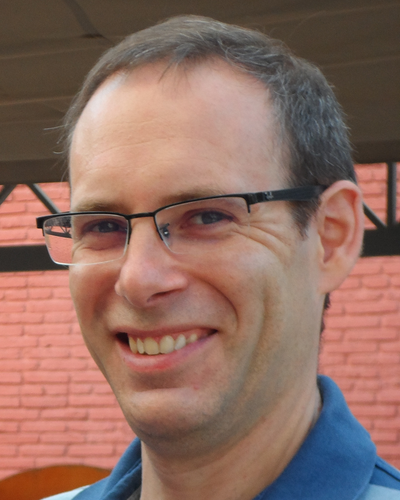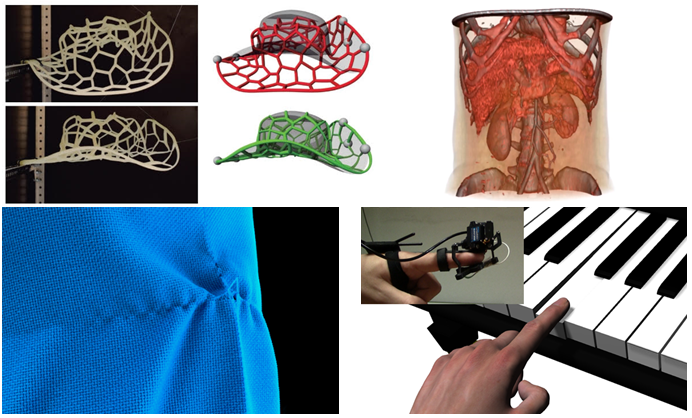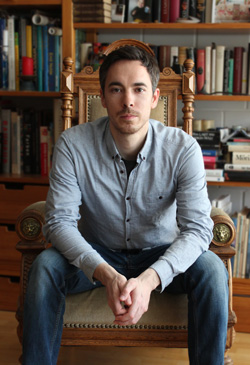Program schedule
Keynote speakers

Miguel A. Otaduy
[Day 2: Tuesday, October 17th] 09:00 - 10:00
Associate professor of Universidad Rey Juan Carlos (URJC Madrid)
Miguel Otaduy is a professor at Universidad Rey Juan Carlos, where he leads the Multimodal Simulation Laboratory http://mslab.es. He obtained his PhD in computer science at the University of North Carolina in 2004, and he was a research associate at ETH Zurich from 2005 to 2008, when he joined URJC. His research seeks novel models and algorithms to simulate mechanical phenomena in a wide variety of applications involving dynamic systems. These include medical training and planning, computer animation and videogames, computational design and virtual prototyping, computer haptics or virtual touch, and even molecular dynamics for drug design. He pays special interest to the robust and efficient solution of contact and interaction between different objects, particles, or materials. He aims to develop solutions from different angles, including geometric algorithms, efficient discretizations, numerical methods, directable simulation, the use of precomputed or measured data, massively parallel computing, or user interaction. Miguel Otaduy is currently associate editor for the IEEE Trans. on Visualization and Computer Graphics and the IEEE Robotics & Automation Letters. He has also served as program chair for the ACM SIGGRAPH / Eurographics Symp. on Computer Animation, the ACM SIGGRAPH Symp. on Interactive 3D Graphics & Games, and the IEEE World Haptics Conference.
Computer animation fuels new design engines
Design is ubiquitous, and computer graphics has been an integral tool for design since the early days of CAD. The relevance of CAD in computer graphics is experiencing a revival, and computer animation is no exception. Computer animation provides a means to create computer models of objects, bodies, or other phenomena, which can then be used within a CAD application. Beyond movies and video games, computer animation enjoys the opportunity to transform the way in which we approach design. This talk will cover several examples of computer graphics research, where computer animation models, together with optimization tools, build the engine of design applications. The examples cover the animation of diverse materials such as skin, soft tissue, cloth, or flexible fabrication materials, and they find impact in diverse applications such as medicine, fabrication, or fashion.


Johannes Kopf
[Day 3: Wednesday, October 18th] 09:00 - 10:00
Research Scientist of Facebook
Johannes Kopf is a research scientist in the Computational Photography group at Facebook in Seattle. Before joining Facebook, he has been working for Microsoft Research, and even before, he received a PhD from the University of Konstanz, Germany. Johannes has received the Eurographics Young Researcher Award in 2013, and the ACM SIGGRAPH Significant New Researcher Award in 2015 for his contributions to the fields of digital imaging and video. Johannes' work is in the fields of computer graphics and vision. More specifically, his past research spans a variety of areas including computational photography, image-based rendering, image and texture synthesis, and digital imaging and video.
Image-based modeling and rendering
The field of computer vision has long been working on the problem of reconstructing three-dimensional models from two-dimensional images, while the field of computer graphics has been---in a way---working on the opposite problem of rendering compelling two-dimensional images from a given three-dimensional scene description. The two fields are coming together in the area of Image-based Modeling and Rendering (IBMR). These methods perform a purpose-driven reconstruction and re-projection of a set of input images or video with the goal of synthesizing novel views of the same scene or performing other interesting image manipulations. Compared to modeling from scratch, IBMR often has often the advantage of better retaining the photographic quality of the input image set. In addition, the reconstruction is often automatic, which makes the systems suitable for casual users. In this talk I will look at the (more recent) history of this area and present a selection of interesting systems and algorithms, focusing on practical applications. I will also discuss open problems and interesting directions for future research in this area.


Hirokazu Kato
[Day 4: Thursday, October 19th] 09:00 - 10:00
Professor of Nara Institute of Science and Technology
Dr. Hirokazu Kato received Dr. Eng. degrees from Osaka University, Japan in 1996. He has worked for Osaka University and Hiroshima City University and since 2007 he has been working for Nara Institute of Science and Technology. Dr. Kato has studied about Augmented Reality for more than 15 years. He developed a vision-based tracking library called the ARToolKit in 1999 which has had a significant impact on the growth of Augmented Reality research. Dr. Kato received Virtual Reality Technical Achievement Award from IEEE VGTC in 2009 and Lasting Impact Award at the 11th IEEE International Symposium on Mixed and Augmented Reality in 2012.
What is the next stage of Augmented Reality
Augmented Reality (AR) has been studied for more than 20 years. Nowadays we can see a lot of AR applications such as PokemonGO. Some people think that AR technologies are almost completed and it has moved to a practical phase. But it is not true because current AR applications are not ideal style of AR. AR researchers still have to make the next breakthrough. In this talk, I would like to introduce my past works on AR and then explain my idea about what AR researchers have to do for the next breakthrough. After that I will briefly talk about my current research works which I am expecting to make the next breakthrough for AR.
